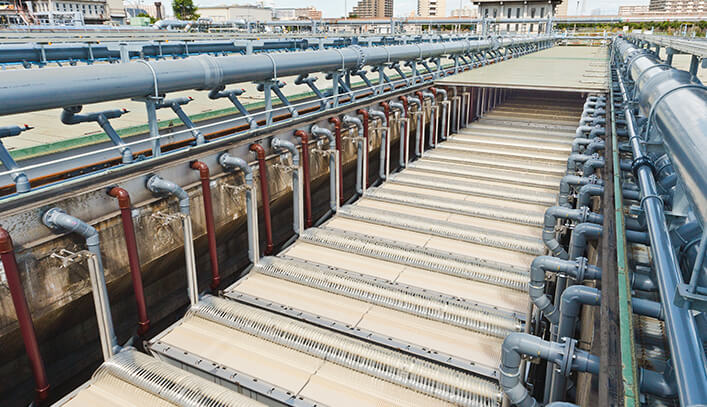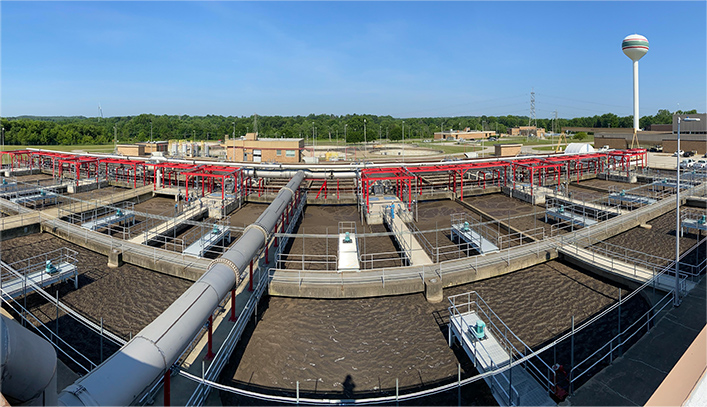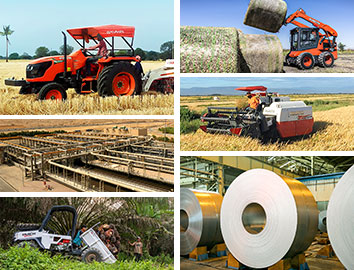Our Commitment to Conserving Resources and the Environment through Wastewater Purification
Membrane Solutions
Kubota is perhaps best known for its agricultural machinery, but we are also involved in water-related projects. We provide a comprehensive array of solutions, from pipes, pumps, valves and other parts to engineering and maintenance of water treatment facilities. All over the world today, people face problems such as water pollution and fresh water scarcity. As part of our efforts to solve these problems, Kubota has developed the KUBOTA Submerged Membrane UnitTM, a technology that purifies sewage and industrial wastewater into reusable water.
Water problems for the human race: Water pollution and fresh water scarcity
Water covers about 70% of the Earth's surface, but most of it is seawater. Only about 2.5% of the total amount is fresh water, and the amount available for human use is said to be a mere 1%*. Freshwater resources are in limited supply, and this supply has been dwindling in recent years due to global warming and population growth, and making fresh water scarcity an even more urgent problem.
On top of that, large amounts of domestic and industrial wastewater are being discharged into rivers in rapidly urbanized areas where infrastructures have not yet been developed, leading to water pollution that destroys ecosystems and threatens the health of downstream residents.
- UN-Water 2014
The key to solve water problems is “Wastewater Reuse”
One of the ways Kubota has been working to solve fresh water scarcity and water pollution problems is wastewater reuse.
Besides drinking, water is used in a wide variety of applications, from toilet flushing, cleaning, and firefighting to decorative fountains in parks. And each application requires a different level of water quality. By reusing the wastewater that had previously been discarded, we can more effectively utilize our limited fresh water resources. In the Middle East and other regions where fresh water is particularly valuable, the reuse of wastewater for irrigation and landscape use has contributed to improving soil quality and beautifying scenery, and has also lead to the protection of precious drinking water source.
Magic technology that generates “New Water”
The activated sludge* process, which removes solids, organic matter, and other pollutants from domestic and industrial wastewater with the action of microorganisms, was first implemented in England about 100 years ago. Today it serves as the mainstream wastewater treatment method. (*Activated sludge is aggregate of microorganisms.)
Kubota introduced KUBOTA Membrane Bioreactor (MBR) process, a combination of the activated sludge process and our exclusive KUBOTA Submerged Membrane UnitTM (Below is called 'KUBOTA SMU') in 1990. KUBOTA SMU has membrane sheet which is made from chlorinated polyethylene and which has average pore size of 0.2µm that is finer than a coffee filter. It is submerged in an aeration tank to separate activated sludge from treated wastewater.
In the activated sludge process, a settling tank is required at the end of process to separate the activated sludge from the treated water. However, MBR process handles solid-liquid separation with the membrane filtration equipment, eliminating the need for a settling tank. This makes the footprint much smaller, while making the treated water remarkably pure.
The ability of MBR to provide treated water with excellent quality at a stable supply is one of this technology's best features. While the quality of effluent from conventional activated sludge process (CAS) can be easily influenced by fluctuation in the quality or quantity of influent, effluent of MBR process is stable and hygienically safe because membrane with extremely fine pores is used for solid-liquid separation. Therefore MBR-treated water can be reused for toilet flushing and other in-building uses, as well as for sprinkling and irrigation. That is why the technology is being utilized in regions strongly concerned about fresh water scarcity issues as an advanced water treatment technology that generates usable “New Water.”
Another feature of MBR is that the footprint is remarkably smaller than that of conventional activated sludge process. It enables the existing facilities with restricted footprints to have increased capacity and more advanced treatment ability. The MBR-treated water can be reused for toilet flushing within buildings and factories, ponds in parks, and many other applications.
Using this technology of MBR, Kubota is committed to enabling more effective use of fresh water resources.
Aiming for enhancement of efficient fresh water use with the energy-saving KUBOTA MBR process
The KUBOTA Submerged Membrane UnitTM is helping to solve fresh water scarcity and pollution problems around the world. To satisfy the needs of the market better, Kubota has spent years developing its MBR technology based on experience gained through thousands of KUBOTA MBR references worldwide.
The challenge we must overcome to make MBR more common on a global scale is reduction of electricity cost. The drawback of the technology is that it consumes more power than conventional activated sludge systems, which has hindered its adoption at large-scale treatment facility. However, by overcoming various challenges one by one, we have succeeded in introducing KUBOTA MBR process at a large-scale treatment facility whose flow is more than 100,000 tons per day. In 2016, the largest wastewater treatment facility in North America using KUBOTA MBR process opened in Canton, Ohio, USA.
There is no end to Kubota's efforts. To bring power consumption closer to that of conventional activated sludge processes, we are not only improving development of the KUBOTA Submerged Membrane UnitTM, but also putting our water treatment engineering capabilities to work. This includes making pumps and other KUBOTA Submerged Membrane UnitTM auxiliary equipment more energy-efficient, setting up operation control methods to make entire facilities run more efficiently, and other efforts in a thorough reevaluation of our energy-saving measures. Our goal is to perform more advanced wastewater treatment technology of MBR work with the same energy consumption level as conventional systems. If we can achieve this, then large-scale facilities will begin adopting the technology at an even faster pace.
From here onward, Kubota will aim to enhance its technological capabilities as a total water solutions company. We want to improve our technologies so that as many people as possible can have access to safe water.













